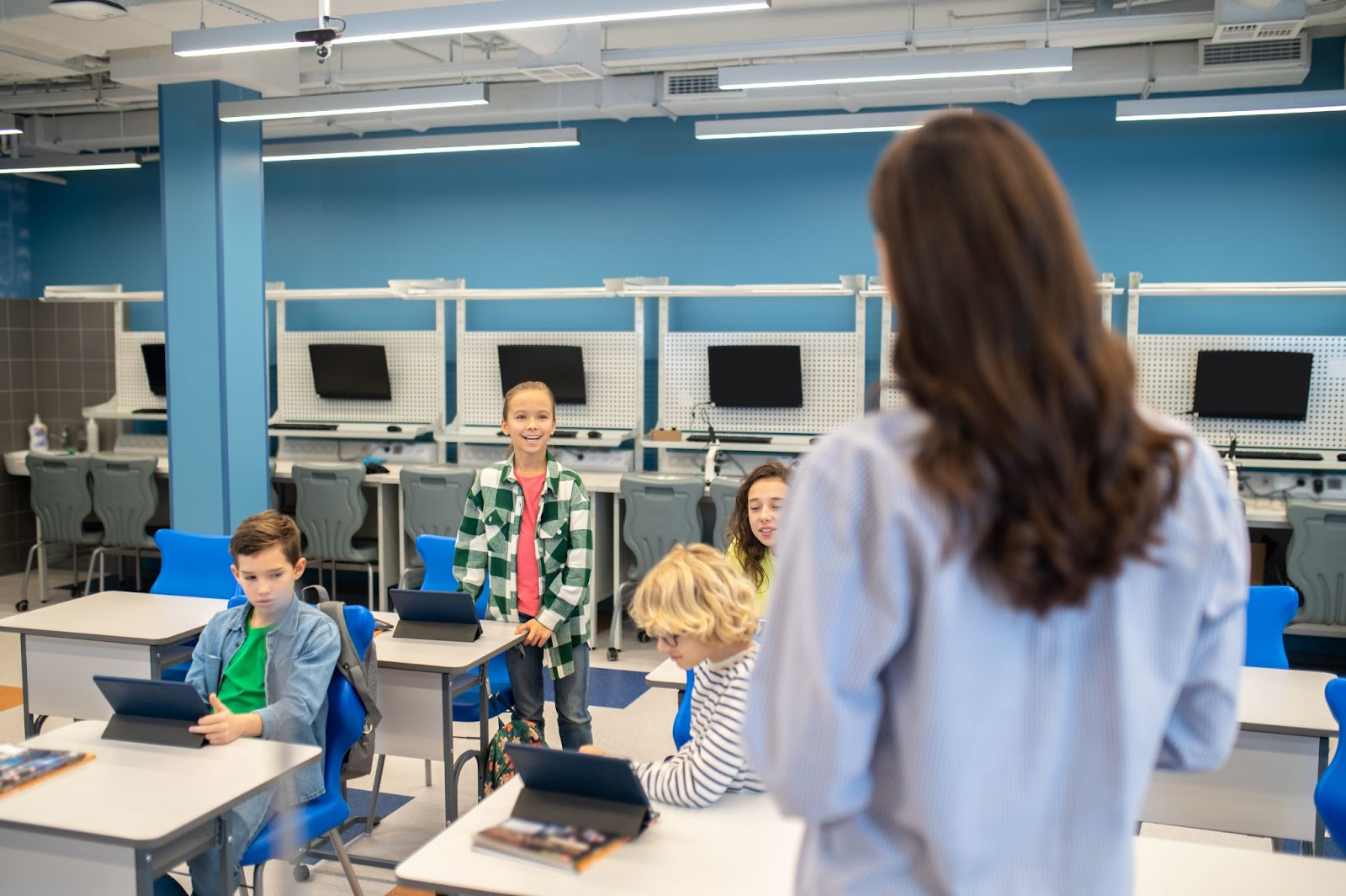The Future of Teaching with Digital Boards [2025 Insights]
.jpg)
In 2025, Indian classrooms are going through a quiet revolution. Chalk and duster are fading. Smart, connected tools are rising. At the heart of this change is the digital board—a dynamic screen that’s changing how students learn and how teachers teach.
But what’s driving this shift? Why now? And why does it matter?
Whether you're a school principal, a college dean, or a tech-savvy teacher, this blog is your guide to understanding the future of digital boards in India. It covers how they’re transforming teaching and what to consider when choosing one.
Why Traditional Boards Are No Longer Enough
We all remember the blackboard. It’s simple. It’s reliable. But it was designed for a different time. In today’s world, where students are used to videos, apps, and interactive games, static teaching is not engaging anymore.
1. Limited Interactivity
Chalkboards and whiteboards can’t do much beyond writing. There's no way to show videos, slides, animations, or live content. Teaching stays one-directional.
2. Passive Learning
Most classrooms still follow the lecture model. The teacher speaks. The students listen. Engagement drops. Attention wanes. Participation stays low.
3. Accessibility Gaps
Every student learns differently. Some are visual learners. Some prefer audio. Others need repetition. Traditional boards cater to just one style—text.
4. Manual Note-Taking
Students have to copy everything down. This leads to missed points, slower understanding, and no chance to revisit later.
5. Delayed Assessment
In a traditional setup, feedback takes time. Tests happen weekly or monthly. By the time students get results, the learning gap has widened.
What is a Digital Board for Modern Teaching?

Source: Freepik
Also known as a smart board, a digital board is a large touchscreen display that connects to the internet, works with digital pens, and runs multimedia content. Think of it as a giant tablet for your classroom.
But it isn’t just a fancier version of a projector. It’s a complete teaching ecosystem.
It allows educators to:
- Show HD videos and animations
- Use interactive apps
- Write using stylus or finger
- Save and share notes instantly
- Conduct live quizzes and polls
- Integrate with Google Classroom, Zoom, or any LMS
- Record and share entire sessions
And when paired with platforms like Roombr, it becomes an all-in-one classroom solution.
Why Digital Boards Are Taking Over in 2025
The digital board isn’t new. But what’s happening in 2025 is different. There’s a perfect storm of policy, technology, and demand that makes this the right time for Indian institutions to make the shift.
Here’s why.
1. Aligned with NEP 2020
India’s New Education Policy encourages interactive, activity-based learning. The digital board supports this. Teachers can present concepts visually. Students can solve problems on-screen. Assessments can happen on the spot.
2. Blended Learning is the New Normal
After COVID-19, hybrid classrooms are here to stay. Many schools are mixing online and offline. Digital boards bridge that gap by allowing real-time lessons, recordings, and content sharing.
3. Increasing EdTech Adoption
More schools and colleges now have access to better infrastructure and internet. Parents and students are familiar with online learning tools. Teachers are more open to digital methods.
4. Demand for Visual Learning
Studies show students retain more when learning with visuals. With subjects like science, geography, and math, digital boards make explanations easier and more effective.
Top Features Educators Should Look For in a Digital Board
Not all boards are created equal. Here’s what you should look for:
1. AI-Based Insights
Advanced digital classroom solutions like Roombr come with built-in AI that tracks student engagement. This allows teachers to see what’s working and adjust their teaching style accordingly.
2. Regional Language Support
India is diverse. A good digital board should support multiple Indian languages—Hindi, Tamil, Marathi, Bengali, and more.
3. Interactive Assessments
Live quizzes, polls, and drag-and-drop tests make learning fun and immediate. Instant feedback helps identify gaps quickly.
4. Cloud and LMS Integration
Teachers should be able to upload content, assign homework, and track progress from anywhere. Boards that sync with LMS platforms make this possible.
5. Multi-Device Compatibility
Good boards support phones, laptops, tablets, and USB drives. Students and teachers can bring their content and devices to class without tech barriers.
6. Durability and Warranty
Education is a long-term investment. Choose boards that offer after-sales support, warranty, and remote troubleshooting.
How Digital Boards Improve Student Outcomes

Source: Freepik
1. Higher Retention
Students remember better when they see and interact with the lesson. Digital boards make it easy to include videos, diagrams, and animations that simplify complex topics. Visual content improves long-term memory and helps students recall key concepts during exams. It turns passive note-taking into active understanding.
2. More Engagement
Traditional lectures often lead to students tuning out. Digital boards bring lessons to life through quizzes, games, and real-time participation. This keeps students alert and involved throughout the class. When learning feels like interaction, attention naturally improves.
3. Better Assessment
Digital boards offer instant quizzes, polls, and feedback tools built right into the system. Teachers can quickly see who understands the topic and who needs more support. This helps close learning gaps on the spot, not weeks later. Real-time assessment means better learning outcomes.
4. Greater Inclusivity
Not all students learn the same way, and digital boards support that. They allow teachers to use audio, visual aids, and regional languages to make lessons accessible. Students with different learning styles or language backgrounds feel more included. It creates an equal learning opportunity for everyone.
5. Improved Teacher Productivity
Teachers can prepare, deliver, and save lessons on one device. Digital boards reduce manual work like drawing diagrams or rewriting notes. They also allow lesson recording and sharing, which saves time and effort. This gives teachers more time to focus on teaching, not just managing.
What the Data Says: Real-World Impact
It’s not just theory. Digital boards are showing measurable success in real classrooms.
According to the National Center for Education Statistics (NCES), over 74% of teachers in tech-enabled classrooms use smartboards to access online resources during lessons. This has directly led to higher student engagement and better attention spans in class. When students see more than just words on a board, they connect faster.
Moreover, studies show that learners in active learning environments, supported by digital tools, consistently achieve better academic outcomes than those in traditional, lecture-heavy classrooms. These tools support diverse learning styles and allow for more hands-on interaction with the content.
Teachers also benefit. With access to online tools, media content, and lesson planning features, digital boards make teaching more efficient. Educators report they can plan faster, adapt quicker, and spend more time teaching rather than managing classroom logistics.
Roombr: India’s Leading All-in-One Digital Classroom Solution
Roombr is more than a screen. It’s a patented Indian solution built specifically for Indian educators.
Here’s what makes Roombr stand out in 2025:
- Dual camera system for recording live sessions
- AI-powered analytics to monitor student participation
- Interactive 120–200” HD display that scales to any room
- Offline + cloud access for schools in rural areas
- Support for regional languages and NCERT curriculum
- Integration with LMS, ERP, and assessment tools
- On-site training and dedicated post-sales support
Whether you’re teaching in a metro or a small town, Roombr makes digital teaching effortless.
Final Verdict: Is 2025 the Right Time?
Yes. Without a doubt.
If you’re waiting for the “right moment” to go digital, this is it. The ecosystem is ready. The tools are mature. The support is available.
Digital boards are not a luxury anymore. They’re a necessity for educational institutions in India.
By adopting Roombr or similar interactive systems, your institution will not only improve academic results but also prepare students for a tech-first future.
FAQs for Educators
1. What is a digital board used for in classrooms?
A digital board is an interactive screen used to teach with videos, images, notes, and live tools. It helps improve engagement, retention, and teaching efficiency in both physical and online classrooms.
2. How are digital boards better than traditional blackboards?
Digital boards support multimedia, real-time feedback, and cloud access. Unlike blackboards, they allow teachers to show videos, run quizzes, and save lessons—making learning more interactive and student-friendly.
3. Are digital boards suitable for Indian schools and colleges?
Yes, smart board solutions like Roombr are built for Indian classrooms. They support regional languages, NEP 2020 goals, offline access, and flexible pricing—ideal for both schools and higher education institutions.
4. Can digital boards improve student results?
Yes. Studies show that digital boards improve student engagement, understanding, and retention. Real-time assessment tools also help teachers identify learning gaps early and adapt their methods accordingly.
5. Do digital boards require teacher training?
Minimal training is needed. Most boards come with simple interfaces and quick onboarding. Brands like Roombr offer demos and support to help teachers get comfortable fast.
Embrace the Future with Roombr’s Smart Digital Classroom Solution
Ready to bring interactive, NEP-aligned learning to your school or college? Roombr’s patented digital classroom solution is designed for Indian classrooms. It features dual cameras, regional language support, AI analytics, and seamless LMS integration. Whether you teach online, offline, or hybrid, Roombr empowers educators to engage students like never before.
Save time, boost outcomes, and future-proof your teaching experience. Don’t just upgrade your digital board—reimagine your entire classroom with Roombr’s all-in-one solution.
Book your free demo and experience the future of teaching—live.
Parvin Khatun
Share
Step Into the future of
Education with Roombr


















